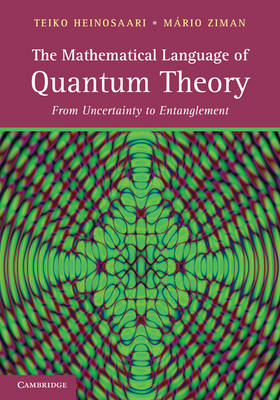|
|
Mathematical structures of quantum theory
- Faculty of Mathematics, Physics and Informatics, Comenius University, Bratislava (5 credits)
- code 2-FTF-227, winter semester (2+1h/week)
- lecturer: Mário Ziman
- undergraduate and graduate students
- prerequisities: quantum mechanics, linear algebra,
- room F2-125, Fridays 12:20-15:00 (subject to change)
Content:
§ 1. Quantum Theory Refresher
§ 2. States and effects
- basic statistical model of an experiment, density operators, convexity,
pure and mixed states, purity
§ 3. Effects and superposition
- duality, convexity, Gleason's theorem, double-slit interference
§ 4. Purification and automorphisms
- tensor product, purification, group of automorphisms, Wigner's theorem
§ 5. Observables
- POVM, convexity, sharp observables,
§ 6. Estimation and discrimination
- informational completeness, minimum-error discrimination, unambiguous
discrimination
§ 7. Quantum channels
- complete positivity, Stinespring dilation theorem,
§ 8. Representations of quantum channels
- Kraus decomposition, Choi-Jamiolkowski isomorphism, convexity
§ 9. Classes of channels
- contractive, qubit channels,
§ 10. Time evolution
- time, master equations, Schrodinger equation
§ 11. Instruments
- quantum operation, projection "postulate", repeatability
§ 12. Measurement models
- Stern-Gerlach apparatus, photodetector
Exam:
- homeworks (20 p + at least 5 bonus points), written test (10b) plus (optional) oral exam
- A (>25 p), B(>20 p), C(>15 p), D(>10 p), E(>5 p)
Literature:
T.Heinosaari, M.Ziman:
The Mathematical Language of Quantum theory (Cambridge, 2012)
T.Heinosaari, M.Ziman:
Guide to mathematical concepts of quantum theory,
Acta Physica Slovaca 58, 487-674 (2008)
Homeworks:
Set 5 (ideally due 07/11/2014)
5.1 Consider a three-valued polarization observable
F0=k |V⟩⟨V|,
F+=k |+⟩⟨+|,
F-=k |-⟩⟨-|,
where |V⟩, |±⟩ = ± cosη|V⟩+ sinη|H⟩
are unit vectors (|V/H⟩ stands for vertical/horizontal polarization)
and k is some positive constant. Find values of k and η
for which these operators determines a valid POVM. (1p)
5.2 Illustrate the statistical map for the observable from the
Task 5.1 above. (1p)
Set 4 (ideally due 24/10/2014)
4.1 Consider a measurement apparatus being internally a uniform mixture
of ideal Stern-Gerlach apparatuses oriented along the axis Z, or X.
Find POVM description for such measurement. (1p)
4.2 Find conditions (in terms of its eigenvalues) under which an effect
E can describe two different outcomes of the same measurement. (1p)
Set 3 (ideally due 17/10/2014)
3.1 Is it possible to increase the purity of states by mixing them together? (1p)
3.2 Suppose you are give two sources. First producing systems in a state |ψ⟩ and the second producing systems in a state |φ⟩. How to check whether one of them is a superposition of the other. (1p)
Set 2 (ideally due 10/10/2014)
2.1 Consider a physical system associated with two-dimensional Hilbert space. Find explicit range of parameters (in the basis of Pauli operators) determining the set of states. (1p)
2.2 Consider a physical system associated with two-dimensional Hilbert space. Find explicit range of parameters (in the basis of Pauli operators) determining the set of states. (1p)
Set 1 (ideally due 03/10/2014)
1.1 Suppose we obtain a box containing 10 photons. We know that either there
are 5 horizontally and 5 vertically polarized photons, or 5 left-circular and 5 right-circular polarized photons. Is it possible to say which box we received? If you have an answer, please describe why? (1p)
1.2 Let S be the swap operator acting on tensor product of isomorphic Hilbert spaces as follows S(|φ⊗ψ⟩)=(|ψ⊗φ⟩) on any pair of vectors |φ⊗ψ⟩. Show that for all operators ρ and ξ the following identity holds: trS(ρ⊗ξ)=tr[ρξ]. (1p)
Bonus 1
What is measured by a realistic photon-resolving photodetector? In other words: determine effects describing the registration of N photons providing
that the efficiency of detecting individual photons is η. (2p)
Bonus 2
Use an observable from Taks 5.1. to discriminate between three pure states
|V⟩, |+⟩, |-⟩. In particular, when an outcome
Fj is observed then we conclude the state |j⟩ is prepared.
Evaluate the probability of error? (2p)
Bonus 3
Prove that measurements of position and momentum (using in a random manner)
are not informationally complete. (2p)
|
|
